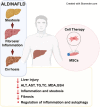Recent Advances in Mesenchymal Stem/Stromal Cell-Based Therapy for Alcohol-Associated Liver Disease and Non-alcoholic Fatty Liver Disease
- PMID: 38016185
- PMCID: PMC10872699
- DOI: 10.1093/stcltm/szad082
Recent Advances in Mesenchymal Stem/Stromal Cell-Based Therapy for Alcohol-Associated Liver Disease and Non-alcoholic Fatty Liver Disease
Abstract
Alcohol-associated liver disease (ALD) and non-alcoholic fatty liver disease (NAFLD) represent pathological conditions that include many distinct stages, potentially leading to the final stage of cirrhotic liver. To date, liver transplantation is the sole successful treatment with concomitant limitations related to donor organ shortage and the need of life-long immunosuppressive therapy. Recently, cell-based therapies for ALD and NAFLD have been proposed with mesenchymal stem/stromal cells (MSCs) as promising effectors. MSC therapeutic applications offer hepatoprotection, regulation of the inflammatory process and angiogenesis particularly in ALD and NAFLD pre-clinical disease models. Recent studies suggested that hepatospecific MSC-based therapies could benefit liver diseases by restoring liver function and decreasing inflammation and fibrosis. Similarly to solid-organ transplantation, limitations in MSC approaches include donor availability exacerbated by high number of cells and cell trapping into lungs. Herein, based on recent advances, we discuss the use of MSCs as a therapeutic approach for ALD and NAFLD and we provide the available information for the establishment of a framework toward a potential clinical application.
Keywords: alcohol-associated liver disease; alcoholic steatohepatitis; cell therapy; fatty liver; mesenchymal stem/stromal cells; non-alcoholic fatty liver disease; non-alcoholic steatohepatitis.
© The Author(s) 2023. Published by Oxford University Press.
Conflict of interest statement
The authors declared no potential conflicts of interest.
Figures


Similar articles
-
Current Therapeutic Options and Potential of Mesenchymal Stem Cell Therapy for Alcoholic Liver Disease.Cells. 2022 Dec 21;12(1):22. doi: 10.3390/cells12010022. Cells. 2022. PMID: 36611816 Free PMC article. Review.
-
Targeting Myeloid-Derived Cells: New Frontiers in the Treatment of Non-alcoholic and Alcoholic Liver Disease.Front Immunol. 2019 Mar 27;10:563. doi: 10.3389/fimmu.2019.00563. eCollection 2019. Front Immunol. 2019. PMID: 30972062 Free PMC article. Review.
-
Multipotent mesenchymal stromal cells: A promising strategy to manage alcoholic liver disease.World J Gastroenterol. 2016 Jan 7;22(1):24-36. doi: 10.3748/wjg.v22.i1.24. World J Gastroenterol. 2016. PMID: 26755858 Free PMC article. Review.
-
Alcoholic liver disease confers a worse prognosis than HCV infection and non-alcoholic fatty liver disease among patients with cirrhosis: An observational study.PLoS One. 2017 Oct 27;12(10):e0186715. doi: 10.1371/journal.pone.0186715. eCollection 2017. PLoS One. 2017. PMID: 29077714 Free PMC article.
-
Extracellular vesicles in fatty liver disease and steatohepatitis: Role as biomarkers and therapeutic targets.Liver Int. 2023 Feb;43(2):292-298. doi: 10.1111/liv.15490. Epub 2022 Dec 30. Liver Int. 2023. PMID: 36462157 Review.
Cited by
-
Cell therapy for end-stage liver disease: Current state and clinical challenge.Chin Med J (Engl). 2024 Dec 5;137(23):2808-2820. doi: 10.1097/CM9.0000000000003332. Epub 2024 Nov 18. Chin Med J (Engl). 2024. PMID: 39602326 Free PMC article. Review.
-
Enhanced In Vitro Recapitulation of In Vivo Liver Regeneration by Co-Culturing Hepatocyte Organoids with Adipose-Derived Mesenchymal Stem Cells, Alleviating Steatosis and Apoptosis in Acute Alcoholic Liver Injury.Cells. 2024 Aug 4;13(15):1303. doi: 10.3390/cells13151303. Cells. 2024. PMID: 39120332 Free PMC article.
-
Induced pluripotent stem cell-derived mesenchymal stem cells for modeling and treating metabolic associated fatty liver disease and metabolic associated steatohepatitis: Challenges and opportunities.World J Stem Cells. 2025 Feb 26;17(2):99331. doi: 10.4252/wjsc.v17.i2.99331. World J Stem Cells. 2025. PMID: 40061260 Free PMC article. Review.
-
Atg5-deficient mesenchymal stem cells protect against non-alcoholic fatty liver by accelerating hepatocyte growth factor secretion.Cell Commun Signal. 2024 Dec 3;22(1):579. doi: 10.1186/s12964-024-01950-x. Cell Commun Signal. 2024. PMID: 39627775 Free PMC article.
-
Innovative Strategies for Liver Transplantation: The Role of Mesenchymal Stem Cells and Their Cell-Free Derivatives.Cells. 2024 Sep 25;13(19):1604. doi: 10.3390/cells13191604. Cells. 2024. PMID: 39404368 Free PMC article. Review.
References
MeSH terms
Grants and funding
LinkOut - more resources
Full Text Sources
Medical

